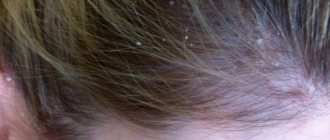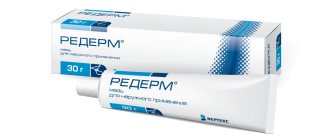Clinical picture
Separately, the ears rarely succumb to rashes. In addition to them, damage to a wide area of the scalp, temporal region, lobes and folds is often observed. It happens that a rash forms in the middle of the ear canal, where it is not visible at all, and this delays the start of therapy and complicates the course of the disease. Peeling in this area occurs only when large areas of the scalp are damaged.
Psoriasis of the auricle is a seborrheic form of psoriasis. The reasons have not been studied; Risk factors include climate change, pregnancy, stress, hormonal imbalance, allergies, and heredity.
Symptoms: skin tightness, itchy pink bumps with a terminal film under peeling, sometimes foul-smelling discharge. Diagnosis - scraping examination.
The treatment is complex: corticosteroids, antihistamines, keratolytics, vitamins, immunocorrectors are used; physiotherapy.
Sometimes the high-speed separation of cells is distributed over the face, neck, and décolleté. It is impossible to predict where exactly the pathology will spread. Spots can appear on the earlobes, and only then on the face and neck. The ear canal and internal part are most often affected.
As a rule, treatment of psoriasis in the ears is carried out on an outpatient basis.
In case of severe swelling of the ear canal and the addition of an infection of a bacterial, viral or fungal nature, hospitalization with subsequent treatment in a hospital is indicated.
Cosmetologist, dermatologist, trichologist
Kalinina Olga Alexandrovna
4 years of experience
Before starting treatment for psoriasis, it is necessary to ensure the accuracy of the diagnosis. It is practically impossible to completely get rid of the disease; it is only possible to suppress the symptoms with the appearance of a long-term remission. If left untreated, the affected area increases and the symptoms worsen.
Psoriasis acts at the cellular level, significantly reducing human immunity. In this regard, the patient develops other pathologies that can lead to serious consequences.
Consequences of psoriasis in the ears
If the patient refuses treatment for a long time, this will inevitably provoke complications of psoriasis in the ears, such as:
- severe inflammation, infection penetration deep into the ear canal;
- deep injuries in the ears;
- hearing impairment;
- generalization of the process - the rash can cover all other parts of the body;
- the appearance of so-called keratonic hair cylinders. They will be freely removed from the head if accidentally touched or combed.
Causes
According to statistics, 3% of the population is affected by psoriasis. The lesion appears in men and women, regardless of age, even in young children. The reasons for the development of the disease have not yet been fully studied.
Blood tests for psoriasis
Chronic dermatosis of non-infectious etiology - psoriasis, is characterized by an unstable course of the disease.
The main provoking factors of psoriasis are:
- hereditary predisposition (when one parent is sick, the child’s risk of development is approximately 8%, when both are 41%);
- early infections (bacteria, viruses) lead to disruption of the genetic apparatus of cells;
- nervous shock, constant stress, depression;
- pregnancy;
- unhealthy diet (vinegar, mayonnaise, smoked and fatty foods, etc.);
- alcoholic drinks (champagne, beer);
- skin injuries
- use of medications (antidepressants);
- sudden climate change;
- endocrine changes;
- allergies to household chemicals.
Psoriasis occurs in one ear or both at the same time. If motivating factors and frequent interaction with water are neglected, the disease begins to spread faster.
How and with what to treat ear psoriasis?
If the diagnosis of ear psoriasis is confirmed, then effective therapy is selected. When compiling it, the age and general condition of the patient, the severity of skin lesions, and the factor provoking the disease are taken into account. Treatment should be comprehensive and eliminate not only the symptoms of the pathology, but also its cause of development.
The following methods are used:
- medicinal;
- physiotherapy;
- folk
The following medications are usually prescribed:
- hormonal and non-hormonal ointments;
- vitamin and mineral complexes;
- enterosorbents;
- immunomodulators;
- antidepressants;
- antihistamines;
- anti-inflammatory.
In mild cases of the disease, you can get rid of the rash at home. If the pathology progresses and is difficult to treat, then hospitalization is required.
Hormonal and non-hormonal ointments
In order to remove papules and restore the dermis, hormonal ointments and creams are prescribed. Their advantage is their ability to quickly relieve the symptoms of psoriasis.
But if taken incorrectly, such drugs can lead to disorders of the vascular, renal and cardiac systems. Therefore, a specialist should select a list of medications and their dosage.
Fucidin ointment
The most commonly prescribed hormonal drugs are:
- ointments based on hydrocortisone (Fucidin, Symbicort, Lokoid). This is the most effective group of medications for ear psoriasis;
- products with triamcinolone (Ftoderm, Nazacort, Kenacort). Give anti-inflammatory, antiseptic, regenerating effect;
- medications based on flumethasone (Flucort, Sinaflan, Sinalar). Relieves itching and flaking. They have an antihistamine effect.
Non-hormonal ointments are characterized by relative safety. But to achieve a therapeutic effect, you need to take a long course. Such remedies are not addictive.
Popular non-hormonal drugs:
- Zinc ointment . Stops the inflammatory process, disinfects wounds. Stimulates natural renewal and restoration of skin cells;
- Salicylic ointment . Used in combination with hormonal medications or as monotherapy. Increases the effectiveness of other medications;
- ointments based on tar (Antipyrin, Colloidin). Used in the treatment of many skin pathologies;
- solid oils (Antipsoriasis, Picladon). Relieves inflammation, cleanses the dermis of the stratum corneum.
Medicines and vitamins for oral administration
Ointments and creams are effective only at the initial stage of ear psoriasis. In severe cases of the disease, oral medications are prescribed. These include drugs with different spectrums of action.
The complex of treatment for psoriasis includes:
- vitamins B, A and C;
- cytostatics (Methotrexate);
- enterosorbents (Sorbex, Enterosgel, activated carbon);
- Hemodez solution;
- aromatic retinoids (Etretinate, Acitretin);
- nonspecific immunotherapy drugs (Aloe, ATP);
- non-steroidal anti-inflammatory drugs (Diclofenac, Indomethacin);
- antihistamines (Cetirizine, Diazolin);
- calcified autologous blood;
- sedatives (valerian tincture, Sedistress);
- immunomodulators (Splenin, Dekaris);
- monoclonal antibodies (Thymodepressin, Adalimumab).
Cytostatics and corticosteroids are used if psoriasis is severe; drugs from other groups do not help.
Treatment with folk remedies
It is recommended to use traditional methods as part of complex therapy. Their advantage is safety and relative cheapness.
Their use allows you to reduce the dosage of synthetic drugs or completely abandon some drugs. The disadvantage of alternative medicine methods is that the effect is achieved after a long time of use.
Effective folk recipes:
- take 300 grams of pork fat, half a liter of vodka and a liter of May honey. Mix everything and add aloe juice. Place the container with the composition in the oven for several hours at a temperature of 180 degrees. Take the medicine in the morning and evening, 2 teaspoons;
- lubricate the affected areas with sea buckthorn oil;
- mix St. John's wort, lingonberry leaves, chamomile, tricolor violet in equal parts and pour a glass of boiling water. Infuse, after the solution has cooled, strain. Drink the mixture throughout the day.
Symptoms
At the first stage of development, psoriasis can be recognized by the inherent itching in the sink area. Papules with noticeable peeling form in or behind the ears.
Symptoms of this form of psoriasis:
- the skin becomes tight;
- small pinkish tubercles with a peeling surface appear;
- of itching appears , followed by irritation and redness;
- inflammatory areas become swollen and red;
- sometimes there is a discharge with a foul odor;
- After some time, a white coating appears in the area of redness.
Since ear psoriasis is similar to eczema, doctors often diagnose an infectious pathology. And therapeutic measures are aimed at eliminating the infection.
Which doctor should I contact?
If flaky rashes appear in your ears, you should consult a dermatologist .
This specialist treats all skin pathologies, including psoriasis. You may need additional consultation with an infectious disease specialist or venereologist. If you are in doubt about which doctor to make an appointment with, then you should go to a therapist.
This doctor has knowledge from all areas of medicine. After the examination, the therapist will determine the type of pathology, the probable cause and refer you for consultation to a more specialized specialist.
In rural areas, the choice of doctors is usually limited. Only a general practitioner or a local doctor can see you at the clinic. In this case, this doctor will select therapy based on existing knowledge.
Psoriasis is a serious disease. And it needs to be treated correctly. Therefore, village residents are advised to come for an appointment with the city doctor.
Diagnostics
Psoriasis usually develops quickly. And since at the beginning of the disease it is difficult to determine the cause, in order not to trigger it, patients are prescribed drug treatment. It helps prevent subsequent development.
Why can our articles be trusted?
We make health information clear, accessible and relevant.
- All articles are checked by practicing doctors.
- We take scientific literature and the latest research as a basis.
- We publish detailed articles that answer all questions.
To correctly establish a diagnosis, it is necessary:
- conduct a laboratory analysis of intestinal microflora;
- scrape off the psoriatic plaque - a stearin stain should appear;
- peel off the scales - the terminal film will be visible there, and if it is damaged, drops of blood will appear.
The main thing is to establish the cause of psoriasis, otherwise a relapse will occur very soon.
Treatment
Having determined the diagnosis, you need to immediately carry out therapy. The prescription for psoriasis is determined by a dermatologist separately for each person. When choosing medications, the specialist takes into account some important factors - the clinical picture, the extent of skin damage, the patient’s age, the duration of the disease and general condition.
Self-medication is dangerous with complications!
Attention
Despite the fact that our articles are based on trusted sources and have been tested by practicing doctors, the same symptoms can be signs of different diseases, and the disease may not proceed according to the textbook.
Pros of seeing a doctor:
- Only a specialist will prescribe suitable medications.
- Recovery will be easier and faster.
- The doctor will monitor the course of the disease and help avoid complications.
find a doctor
Do not try to treat yourself - consult a specialist.
Treatment of ear psoriasis should be comprehensive. Medications alone are unlikely to help. Although this dermatological pathology does not lead to deafness, it should not be left to chance.
Medications
Therapeutic methods are aimed at eliminating symptoms. Drug treatment of psoriatic plaques involves:
- Antibacterial agents - used in the formation of erosions and cracks, where infection can occur or during exacerbation of pathology.
- Vitamins , minerals - to normalize the immune system, as well as vitamin-containing ointments and creams.
- Hormonal corticosteroid drugs are consumed in parallel with salicylic acid-based drugs; For skin regeneration, medications containing calcipotriol are used. They relieve inflammation and other symptoms of psoriasis.
- Keratolytics – help soften, moisturize and further eliminate plaques.
- Antihistamines – relieve itching, redness and irritation of the skin.
- anti-inflammatory - have antifungal, antipruritic, analgesic effects.
- Antidepressants (available by prescription only) are prescribed when a psychological disorder manifests itself, usually caused by discomfort, severe itching, or a burning sensation in the ear.
- The use of monoclonal antibodies restores the mechanism of cell division. Currently, it is a popular method of eliminating this disease.
Diet for psoriasis
Psoriasis is a chronic, non-infectious disease that has many types and forms, accompanied by various symptoms.
In addition, patients with psoriasis of the auricle are prescribed enterosorbents and hepatoprotectors for oral use.
To cure the disease faster, you should provide open access to the damaged skin to clean air and sun.
How to apply medications
Properly selected treatment for ear psoriasis will help cope with pain and discomfort. The drugs will protect the skin from further irritation.
How to apply the product correctly:
- ointment, cream or gel must be smeared into the desired area with clean hands;
- apply them to the damaged area in a thick layer; when it is necessary to treat the surface of the ear, use a cotton swab; if from inside the passage - a cotton pad;
- After performing the procedure, you should wait 20 minutes, only after that go to bed or put on a hat, because the product will be erased.
For psoriatic disease behind the ears, it is helpful to jointly lubricate the outer part that is close to the affected area.
Physiotherapy
In addition to treatment with medications, physical procedures provide good results:
- Herbal medicine involves the effect of ultraviolet rays on areas of inflammation.
- Laser therapy is intended to normalize metabolic processes in the damaged area.
It is worth noting that this pathology does not tolerate amateur activity. Treating ear psoriasis requires a comprehensive and knowledgeable approach. Self-therapy will complicate the situation.
Types of psoriasis
Depending on the location, ordinary and inverse psoriasis are distinguished. The first occurs in 85% of cases and mainly affects the scalp. Scaly redness flakes, bleeds and causes discomfort. The reverse type is characterized by its appearance in hard-to-reach and invisible places. Plaques form under the breasts, in skin folds, armpits, inner thighs and on the external genitalia.
Based on the nature of the manifestations and appearance of formations on the skin, psoriasis is divided as follows:
Pustular
This type is generalized and palmoplantar. The generalized form develops spontaneously and has a difficult course. Blood rushes to the capillaries, and in just a couple of hours, bright red erythema and small pustules appear, which cause burning and pain. Symptoms include fever, leukocytosis and general deterioration of health. Psoriasis of the palms and soles affects the surfaces of the hands and arches of the feet, heels and finger joints.
Exudative
It differs from ordinary psoriasis in that purulent fluid accumulates inside the papules, which is released when the scales are removed from the surface of the skin.
Arthropathic
This is the most serious form, combining symptoms of psoriasis and arthritis. In addition to the characteristic rashes, the patient experiences pain in the joints. Signs of the disease range from mild arthritis in the hands and feet to severe joint deformities and damage to the musculoskeletal system, including disability.
Psoriatic erythroderma
Another severe form of the disease, in which a significant part of the skin is affected. It occurs primarily or against the background of already progressing psoriasis. Signs of erythroderma: bright red skin due to a rush of blood and lymph to the vessels (hyperemia), swelling, local thickening and changes in skin pattern (lichenization), a large number of dry scales. The patient's temperature rises and his general condition worsens.
Hygiene features
When performing treatment for psoriasis, you need to adhere to simple hygiene rules:
- everyday water manipulations should not cause injury to the affected areas;
- dry all areas thoroughly but with caution; Do not rub the skin until it turns red;
- inflammatory foci must be treated with special preparations;
- if psoriatic plaques are located in the middle of the ear, they need to be cleaned with cotton swabs (in no case by inserting them deeply, this can lead to blockage);
- It is advisable to pin or cut your hair, since it is important for ultraviolet radiation to reach the diseased areas (metabolic processes are activated to renew the skin);
- when psoriasis worsens, various effects on the hair can provoke complications, so it is better to shorten the hair (so that it can be combed without difficulty);
- during illness , you should not use a hairdryer or keep it at a distance of at least 30 cm;
- Any cosmetic procedures (hair coloring, perm) are prohibited.
PUVA therapy for psoriasis
PUVA therapy is one of the physiotherapeutic methods used to treat psoriasis.
Avoid scratching the affected area to avoid risk of infection.
It is very important for a patient with psoriasis to maintain hygiene and eliminate bad habits. For severe itching, antiallergic medications may be used.
Necessary diagnostic measures
Ear psoriasis is similar to seborrheic eczema. Therefore, differential diagnosis is carried out.
A person suspected of psoriatic disease is referred for the following examinations:
- immunogram. A laboratory technician examines the blood for the presence of certain indices of immune function. The method shows the activity of the protective forces;
- urine analysis to determine the balance of water and salt in the body, metabolism;
- detection of histocompatibility antigens in the blood. Shows joint damage.
Based on the results of these research methods, a treatment plan is drawn up.
Nutritional Features
The success of treatment of ear psoriasis is directly determined by the patient’s diet and the use of vitamins A, B, C. It is important to maintain the temperature of the prepared dishes. You should not eat very cold or hot food.
In addition, it is not recommended to eat:
- marinades, canned food;
- semi-finished products, sausages;
- dairy products;
- rich broths, animal fats;
- spicy and fried foods, sweet pastries;
- chocolate, citrus fruits;
- spices, smoked meats;
- strong brewed tea, coffee;
- alcohol.
An aggravated form of psoriasis includes seafood, fish, boiled meat, and more vegetables and fruits in the diet.
Prevention
Prevention of ear disease is, first of all, paying close attention to yourself and your body. It is important to monitor your health, build a proper diet, avoid stress and overload, and treat chronic diseases in a timely manner.
We hope that our story about ear psoriasis will be purely informational for you. And if you suffer from plaques on your body, try Rederm ointment with a combination of betamethasone and salicylic acid. The product has a complex effect:
- softens and exfoliates rough skin;
- relieves redness and inflammation;
- eliminates itching;
- reduces allergic manifestations.









